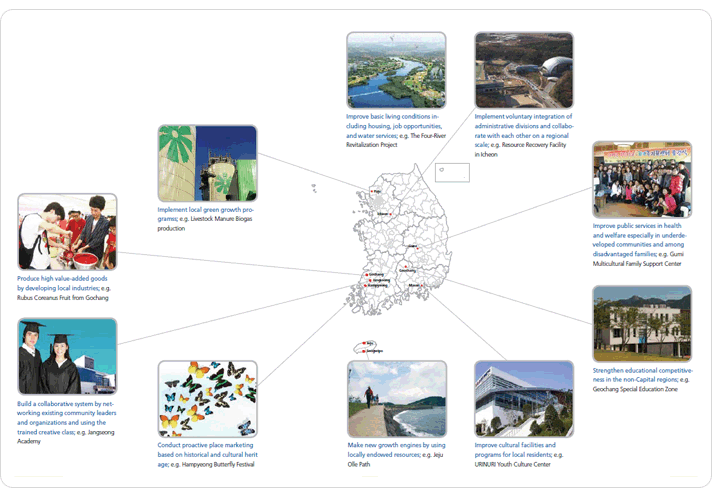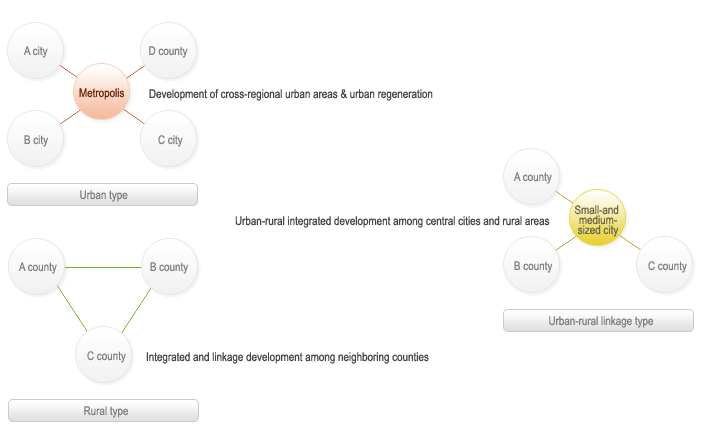- Strategies
- Strategies by Government Agency and Department

To improve settlement conditions of rural areas
- To focus on policy support customized to settlement characteristics
- To promote influx of young people in the 30's and 40's by building rural new-towns
- To designate 176 areas by 2008 and 1,000 by 2017 and provide comprehensive support including living environment improvement, landscape improvement, income-generation base expansion, etc.
To generate income, create employment and activate industries in rural areas
- To actively discover locally inherited resources and boost capacity for industrialization
- To actively nurture indigenous agricultural and food industries, and experiential and relaxation services
To attract businesses from outside and improve investment environment
- To promote advancement of agro-industrial complexes, combining them with the function of corporate support services
- To implement deregulation including restrictions on the ownership and trade of marginal farmland(more than 15% of slope ratio), and promote investment in green energy and relaxation businesses

To build better health services in regions
- To create a basic emergency medical care system to meet emergency medical situations within 30 minutes wherever in the nation
- To provide a 'door-to-door medical services' for areas with low accessibility to medical care
- To build a local public health care system by combining together public health centers, local public hospitals, and local college hospitals
To enhance welfare services customized to regional characteristics
- To expand infrastructure for a healthy old age including a long-term medical treatment and dementia inspection services in preparation for the rapidly ageing society
- To increase hub centers of public health from 45 in 2008 to 253 in 2010 for the disabled
- To expand small nursing facilities based on public and welfare facilities for areas lacking private nursing facilities
- To strengthen support for multi-cultural families, which are rapidly increasing in rural areas, prior to marriage until they adjust to the society
- To reorganize the welfare services delivery system to prevent overlaps or misses, and provide necessary services to those just in need

To expand culture and sports infrastructure
- To actively support cultural activities all over the country
- To strengthen infrastructure establishment and support local experts in culture and arts
- To drastically improve conditions for sports in everyday life
To promote tourism resources development in accordance with regional characteristics
- To establish a system for locality-centered tourism resources development and support
- To develop cultural, historial, and ecological tourism resources reflecting regional characteristics

To provide a high quality environmental services
- To improve water supply and sewage treatment rate in rural villages
- To actively promote the 'Living Waterway 100 Project' to restore a total of 100 waterways to ecological waterways by 2012
- To promote the 'Cheonggye Stream + 20 Project' to restore dry or concrete-covered streams in downtown areas, turning them into cultural and leisure spaces
To put to use outstanding local environmental resources
- To create eco- and relaxation villages in and around three national parks by 2010
- To divide the country into 10 areas and create one to two new and renewable energy complexes in each of the areas by 2020
- To create a total of 600 low carbon green villages, and increase energy self-sufficiency rate in rural areas to 40 to 50% by 2020

In order to enhance the quality of life and settlement conditions in Local Areas, PCRD declared ten tasks for both central and local governments: five bottom-up endogenous development tasks and five top-down exogenous development ones.

Promotion of the Creative Region
The concept of the creative region is similar to Richard Florida’s “creative city”, which has become a global movement reflecting the rise of a new planning paradigm for cities. Recognizing that places hold creative potential, the policy scheme of the creative region posits that Local Areas can develop unique and competitive projects and programs by utilizing their own inherited or endowed resources.
This concept applies to any area, whether local or regional. Creativity is not only about having ideas, but also having the capacity to implement them. Therefore, a creative region must have soft infrastructure, including a highly skilled and flexible labor force of dynamic thinkers, creators and implementers. Furthermore, as part of the creative region policy scheme, the government will promote and facilitate the efforts of local areas with administrative support and financial incentives.
In 2010, PCRD announced the guidelines for creative region projects as follows:
1) In order to effectively support creative efforts of local areas, the PCRD, along with central and local governments will introduce a promotion system including education and training, institutional and administrative support, and financial and budget incentives;
2) In the short term, policy focus will be put on local areas such as cultural, educational and welfare projects, as well as locally inherited products, and then gradually expanded to the ER level to include such projects as cultural city, ubiquitous city, and creative industry;
3) In order to facilitate creative region projects and programs, higher subsidy rates will be given from block grants (regional development special accounts).











![[프로그램입력]](../../images/nav/nav_off_01.gif)
![[프로그램입력]](../../images/nav/nav_off_02.gif)
![[프로그램입력]](../../images/nav/nav_off_03.gif)
![[프로그램입력]](../../images/nav/nav_off_04.gif)
![[프로그램입력]](../../images/nav/nav_off_05.gif)










